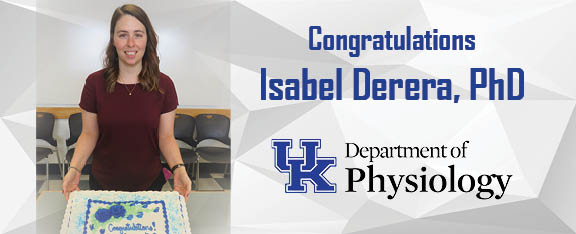Congratulations Isabel Derera, PhD
On Thursday, September 6, 2018 Isabel Diane Derera successfully defended her disseration and was awarded her doctoral degree. Congratulations Dr. Derera!
Alterations in GABAergic NTS Neuron Function in Association with TLE and SUDEP
Doctoral Committee Members
Dr. Bret Smith
Department of Physiology , Mentor
Dr. Brian P. Delisle
Department of Physiology
Dr. Steve Estus
Department of Physiology
Dr. Meriem Bensalem-Owen
Department of Neuroscience
Outside Examiner
Dr. Chris Norris
Department of Pharmacology and Nutritional Sciences
Abstract
Epilepsy is a neurological disorder that is characterized by aberrant electrical activity in the brain resulting in at least two unprovoked seizures over a period longer than 24 hours. Approximately 60% of individuals with epilepsy are diagnosed with temporal lobe epilepsy (TLE) and about one third of those individuals do not respond well to anti-seizure medications. This places those individuals at high risk for sudden unexpected death in epilepsy (SUDEP). SUDEP is defined as when an individual with epilepsy, who is otherwise healthy, dies suddenly and unexpectedly for unknown reasons. SUDEP is one of the leading causes of death in individuals with acquired epilepsies (i.e. not due to genetic mutations), such as TLE. Previous studies utilizing genetic models of epilepsy have suggested that circuitry within the vagal complex of the brainstem may play a role in SUDEP risk. Gamma-aminobutryic acid (GABA) neurons of the nucleus tractus solitarius (NTS) within the vagal complex receive, filter, and modulate cardiorespiratory information from the vagus nerve. GABAergic NTS neurons then project to cardiac vagal motor neurons, eventually effecting parasympathetic output to the periphery. In this study, a mouse model of TLE was used to assess the effect of epileptogenesis on GABAergic NTS neuron function and determine if functional alterations in these neurons impact SUDEP risk. It was discovered that mice with TLE (i.e. TLE mice) have significantly increased mortality rates compared to control animals, suggesting that SUDEP occurs in this model. Using whole cell electrophysiology synaptic and intrinsic properties of GABAergic NTS neurons were investigated in TLE and control mice. Results suggest that during epileptogenesis, GABAergic NTS neurons become hyperexcitable, potentially due to a reduction in A-type potassium channel current and increased excitatory synaptic input. Increases in hyperexcitability have been shown to be associated with an increased risk of spreading depolarization and action potential inactivation leading to neuronal quiescence. This may lead to a decreased inhibition of parasympathetic tone, causing cardiorespiratory collapse and SUDEP in TLE.
Acknowlegments
I would like to thank my mentor Dr. Bret Smith, for his support and guidance throughout my graduate studies. I am grateful to my committee members: Dr. Brian Delisle, Dr. Steve Estus, and Dr. Meriem Bensalem-Owen for providing me with thoughtful feedback and constructive comments during my doctoral training. I am very appreciative of the help and feedback I have received on my project over the years from many Smith Lab members. In particular, I would like to thank Dr. Carie Boychuk and Dr. Jeff Boychuk for training me in electrophysiology and providing troubleshooting expertise with this technique. I would like to thank Dr. Katalin Smith for her help in tissue collection, PCR, and microscopy. I would also like to thank Tanya Seward for her help with ECG telemetry. I am grateful for all the help I have received from the Department of Physiology Director of Graduate Studies, Dr. Kenneth S. Campbell and the administrative staff in the Physiology Department: Tanya Graf, Andrew Hernandez, and Allison Walters. I would like to thank my friends that have provided me with their unwavering support during my graduate studies. Thank you to Dr. Maria Dixon, Dr. Cheavar Blair, Gabby Keb, Beth Oates, and Dr. Erica Littlejohn. I would also like to thank my family and my husband’s family for their support over the past 6 years. Lastly, I am extremely grateful for meeting my husband, Dr. Will Arnold, during this time in my life. Thank you for always looking out for my best interests throughout my graduate training. I am so appreciative of your support as we survived graduate school together.
